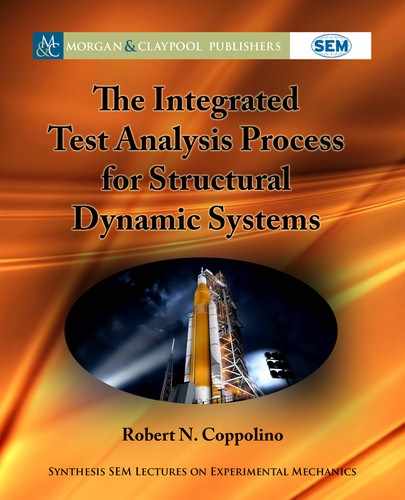
3.1. PART 1: UNDERSTANDING MODAL DYNAMIC CHARACTERISTICS 45
A summary of ideal axisymmetric shell and perturbed shell structure modal frequencies
and kinetic energy metrics (sorted in terms of total “body” and “breathing” kinetic energy dis-
tributions (Equation set (3.13)), for ideal axisymmetric and perturbed shells, is presented in
Figure 3.7.
Ideal Axisymmetric Shell Perturbed Shell
Mode Number Mode Number
Frequency (Hz)
1000
500
0
Breathing KE (%)
80
60
40
20
0
Body KE (%)
80
60
40
20
0
Breathing KE (%)
80
60
40
20
0
Body KE (%)
80
60
40
20
0
Frequency (Hz)
1000
500
0
20 40 60 80 100 120 140
System Mode
Body Mode
20 40 60 80 100 120 140
20 40 60 80 100 120 140 20 40 60 80 100 120 140
20 40 60 80 100 120 140 20 40 60 80 100 120 140
System Mode
Body Mode
Figure 3.7: Axisymmetric and perturbed shell structure modal frequencies and kinetic energy
metrics.
e above result is quite significant, as the vast majority of system modes are associated
with “breathing” deformation, which will be shown in the subsequent discussion on Target Mode
Selection to be relatively insignificant contributors to primary structure dynamic loads.
An in-depth summary of the present illustrative example’s modal metrics, for a represen-
tative subset of the first 150 FEM modes for an ideal axisymmetric shell is provided in Table 3.2.
e following observations result from analysis of modal energy characteristics for the
ideal axisymmetric structure.
1. Twenty-four “body” modes, 126 (n > 1) “breathing” modes.
2. Nine “body” bending modes in each of the “X” and “Y ” directions.
3. Two “body” axial “Z” modes.
4. Two “body” torsion modes.
5. Two “body” mixed axial-bulge modes.
..................Content has been hidden....................
You can't read the all page of ebook, please click here login for view all page.
